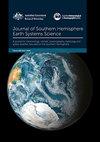南半球(2015年春季):厄尔尼诺Niño接近峰值
IF 3.6
4区 地球科学
Q1 Earth and Planetary Sciences
引用次数: 0
摘要
回顾了2015年南半球春季的南半球环流模式和相关异常,重点介绍了太平洋气候指标和澳大利亚降雨和温度模式。热带太平洋持续存在强El Niño,中东部海表温度异常超过+2°C,日期变更线附近长波辐射呈强烈负向,南方涛动指数呈现较大负向偏离。在冬季形成的印度洋正偶极子在11月下旬消散,但在9月和10月对澳大利亚的气候影响特别大。澳大利亚的春季降雨量在前两个月低于平均水平,但在该季节后期有所改善:西澳大利亚北部的降雨量高于11月的平均水平。然而,春季的地区平均降雨量低于全国平均水平。对澳大利亚来说,10月份是有记录以来最热的月份,也是自1910年以来平均气温异常最高的月份。春季气温高于平均水平,澳大利亚创下了有记录以来第二温暖的春季,仅次于去年创下的记录。本文章由计算机程序翻译,如有差异,请以英文原文为准。
Seasonal climate summary southern hemisphere (spring 2015): El Niño nears its peak
Southern hemisphere circulation patterns and associated anomalies for the austral spring 2015 are reviewed, with an emphasis on Pacific climate indicators and Australian rainfall and temperature patterns. A strong El Niño persisted in the tropical Pacific Ocean with sea-surface temperature anomalies in excess of +2 °C in central and eastern parts, strongly negative outgoing longwave radiation near the Date Line, and the Southern Oscillation Index showing large negative departures. The positive Indian Ocean Dipole that had established in winter dissipated in late November, but was particularly influential on Australia's climate during the months of September and October.Australia’s spring rainfall was below average in the first two months, but improved later in the season: the northern half of Western Australia recorded above average November rainfall. Nevertheless, area-averaged rainfall in spring was below average for the country as a whole. For Australia, October was the warmest on record and had the highest mean temperature anomaly on record for any month since 1910. Spring temperatures were above average and Australia recorded its second-warmest spring on record, behind the record set in the previous year.
求助全文
通过发布文献求助,成功后即可免费获取论文全文。
去求助
来源期刊

Journal of Southern Hemisphere Earth Systems Science
Earth and Planetary Sciences-Oceanography
CiteScore
8.10
自引率
8.30%
发文量
0
审稿时长
>12 weeks
期刊介绍:
The Journal of Southern Hemisphere Earth Systems Science (JSHESS) publishes broad areas of research with a distinct emphasis on the Southern Hemisphere. The scope of the Journal encompasses the study of the mean state, variability and change of the atmosphere, oceans, and land surface, including the cryosphere, from hemispheric to regional scales.
general circulation of the atmosphere and oceans,
climate change and variability ,
climate impacts,
climate modelling ,
past change in the climate system including palaeoclimate variability,
atmospheric dynamics,
synoptic meteorology,
mesoscale meteorology and severe weather,
tropical meteorology,
observation systems,
remote sensing of atmospheric, oceanic and land surface processes,
weather, climate and ocean prediction,
atmospheric and oceanic composition and chemistry,
physical oceanography,
air‐sea interactions,
coastal zone processes,
hydrology,
cryosphere‐atmosphere interactions,
land surface‐atmosphere interactions,
space weather, including impacts and mitigation on technology,
ionospheric, magnetospheric, auroral and space physics,
data assimilation applied to the above subject areas .
Authors are encouraged to contact the Editor for specific advice on whether the subject matter of a proposed submission is appropriate for the Journal of Southern Hemisphere Earth Systems Science.
 求助内容:
求助内容: 应助结果提醒方式:
应助结果提醒方式:


